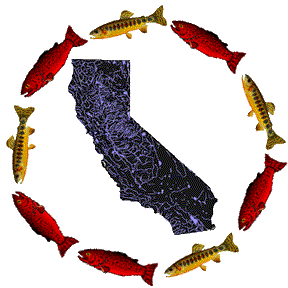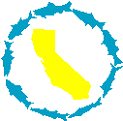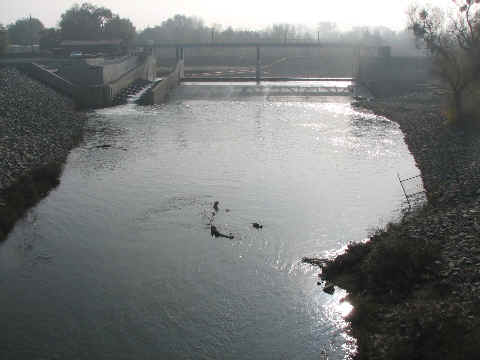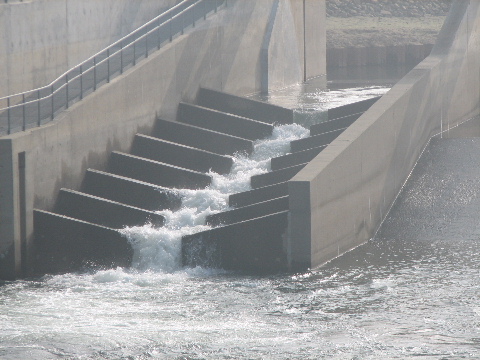|
CSPA |
| Your 501(c)(3) tax deductible cash donations are desperately needed if the fight for our fisheries is to continue. Read how you can donate! |

 More
News
More
News
![]()
 A
salmon crisis in my back yard: Mokelumne River Hatchery at 3% of
capacity
A
salmon crisis in my back yard: Mokelumne River Hatchery at 3% of
capacity
by Jerry Neuburger, CSPA Webmaster
December 13, 2008 -- Lodi, CA -- While most of the emphasis on the
salmon crisis has focused on the fish returning up the Sacramento River,
that river is not the only one in crisis. The Mokelumne River, the river
that flows through Lodi, just a mile from my house is also severely
impacted. In 2002, over 10,300 salmon entered the river above Woodbridge
Dam. This year the number of returning fish is about 100 and the 200,000
salmon eggs at the hatchery are just 3% of its capacity. The Mokelumne
is in trouble again.
 |
| The dam at Woodbridge with a
total flow of about 160 CFS. Photo by Jerry Neuburger |
The river has seen its ups and downs over the years. Droughts, heavy metal run-offs from an abandoned mine, and water mismanagement had caused the salmon population to decline in the late 80's to the point where the dozen or so fish returning one year were given individual names.
The river's sad state was brought to attention of the fishing public with a series of late summer warm water releases from Camanche Dam that killed almost all of the trout and steelhead below the dam. Hundreds of fish could be seen floating down the river from Van Assen Park to Clements, ten miles away. That fish kill and the lack of any real salmon run mobilized the anglers and environmentalists in the area to form the Committee to Save the Mokelumne. One of those who took the lead in that effort is CSPA's current Executive Director, Bill Jennings.
With tons of hard work the stakeholders came together and after some posturing, screaming and table pounding, finally settled down, rolled up their sleeves and started talking to each other. The result was an agreement made in the mid 90's that provided water for the salmon and at the same time delivered flows for farmers and other uses during the various water years from Wet down to Critically Dry. In addition to the water agreements, improvements were promised to the fish ladder at Woodbridge Dam, the water release mechanism at Camanche Dam and the spawning gravel in in the river between Woodbridge and Van Assen Park. CSPA's Bill Jennings, the leader of the Committee to Save the Mokelumne movement was brilliant in working out the complex balancing act between all the parties, an agreement that "worked" for everyone.
 |
| The fish ladder at Woodbridge Dam. Total flow of dam and ladder, 160 CFS. Photo by Jerry Neuburger |
Because of the parties adherence to the agreement and the implementation of the various river improvements, salmon returns skyrocketed. In 1998 a "wet" year, 7213 salmon entered the upper river above Woodbridge Dam, in 1999 a "wet" year, 5,335. in 2000, an "above normal" year, 7,418, in 2001, a "dry" year, 8,114, in 2002, a second "dry" year, 10,757, in 2003, an "above normal" year, 10,241.
Salmon return numbers could not be found for the years 2004, a "below normal" year and 2005, an "above normal" year but in 2006, a "wet" year, 5,839 chinook salmon entered the Mokelumne above Woodbridge dam. Then things turned BAD. In 2007, a "dry" year, only 1500 salmon returned. Even so, this minimal return was enough to stock the hatchery.
This year, 2008, the bottom has fallen out. The year has been classified as, "critically dry." The number of salmon returning to the hatchery has been less than 100. The result is a hatchery with only 200,000 eggs, or three percent of its goal of six million.
Why? The blame was recently laid on the water releases from both East Bay Municipal Utility District (EBMUD) at Camanche and Woodbridge Irrigation District (WID) at its diversion at Lodi Lake, just above Woodbridge Dam.
However, in checking with Andy Christensen, WID, it was found that releases below Woodbridge were from between 65 and 80 CFS for the month of October and above 160 from November on. Were the releases as per agreement? No, they were slightly below the agreed 80 CFS in October but, at an average of about 70 CFS, over three times the old pre-agreement flows of 20 CFS that were identified as the fish killer in the bad old years. The November releases, increased to 160+ CFS, were double the water needed to bring the fish up the river. Once above Woodbridge, the releases by EBMUD exceeded the 220 CFS minimum for the entire period. Could the missing 10 CFS for some of the October flows below Woodbridge be the culprit in such a drastic reduction of returning fish? While the slightly lower flows may have been a contributing factor, were they the main reason for the collapse of the fishery? Not likely. Records show that fish in much greater numbers have made it all the way up the river and past a much poorer fish ladder than the current one with flows of less than 70 CFS. In addition, flows for the month of November at 160+ CFS were more than adequate.
What is the explanation of why the river, once on a fast track to ten thousand fish returns, suddenly crashed? Wet vs. Dry years? No, in looking at the returns over the last ten years river conditions seem to have played only a minor, if any, role in the number of fish returning. In fact, in 2002, the second of two "dry" years in a row saw the greatest return of fish up the river, 10,757.
If not river flows, what then? Oh yes, the striper predation. But wait, the salmon runs were increasing from 1998 through 2002 even though the striper population in the delta was considerably greater than it is now.
If not river flows and not stripers, what then? What has changed since 2002?
Basically one thing, increased pumping by the Central Valley Project (CVP) and the State Water Project (SWP) pumps. Since 2002, the peak of the Mokelumne's return to health, pumping in the south delta has increased by 1/3.
What does that mean? When you consider the location of the Mokelumne and the fact that it empties into the San Joaquin River, a river that is practically a one-way conduit to the pumps, it means that the problem with the Mokelumne is not the lack of returning fish. The problem is that the young salmon trying to reach the ocean never make it. Instead they're sucked up, ground into fish paste in the SWP and CVP pumps and their flesh washed down the aqueducts. With few fish escaping, even fewer return and the problem is compounded, year after year.
YES, It's the pumps and I'm NOT stupid.
Mokelumne Joint Settlement Agreement